The Australian Myrtaceae family of plants, including eucalypts, tea tree and paperbark, and associated plant industries are under threat from a devastating disease called myrtle rust (Puccinia psidii).
Through a PBCRC research project with the NSW Department of Primary Industries (NSW DPI) and Queensland Department of Agriculture and Fisheries (QDAF), scientists are investigating how to manage the impact of myrtle rust – a disease that has the potential to cause widespread change in native plant species and impacts on the ecological communities they support. This research is being led by Dr Suzy Perry and Dr Geoff Pegg from QDAF, with significant support from Dr Angus Carnegie (NSW DPI).
In 2010, myrtle rust was detected for the first time in Australia on the central coast of New South Wales. With the wind-borne nature of the disease and
the abundance of suitable plant hosts in the Australian environment, the disease spread rapidly and is now considered established and widespread along
the entire east coast of Australia.
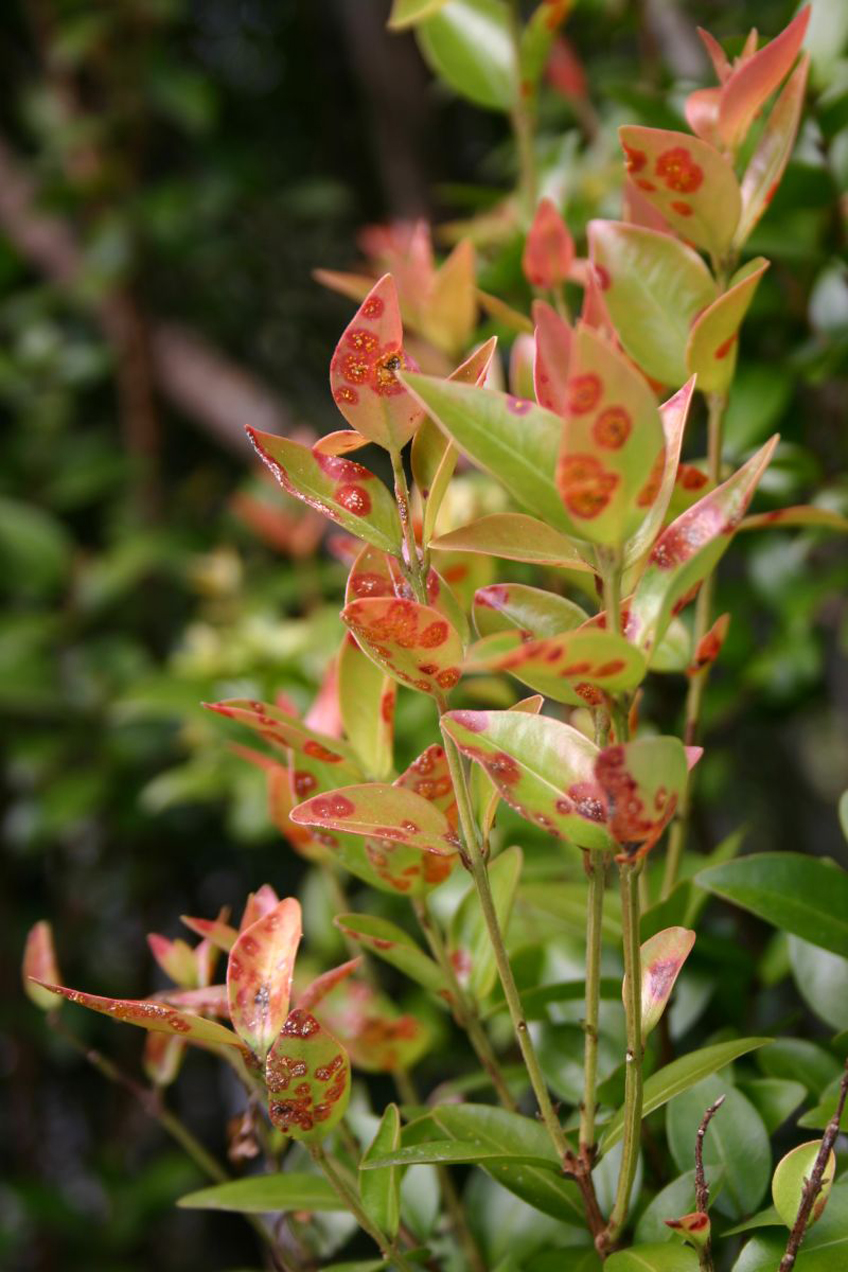
Gossia gonoclada,which is listed as Threatened and is highly susceptible to myrtle rust. Photo - PBCRC
The map below shows the distribution of myrtle rust along the east coast of Australia, and time of spread. This does map does not include detections in
plant nurseries. For a larger version of the map click here.
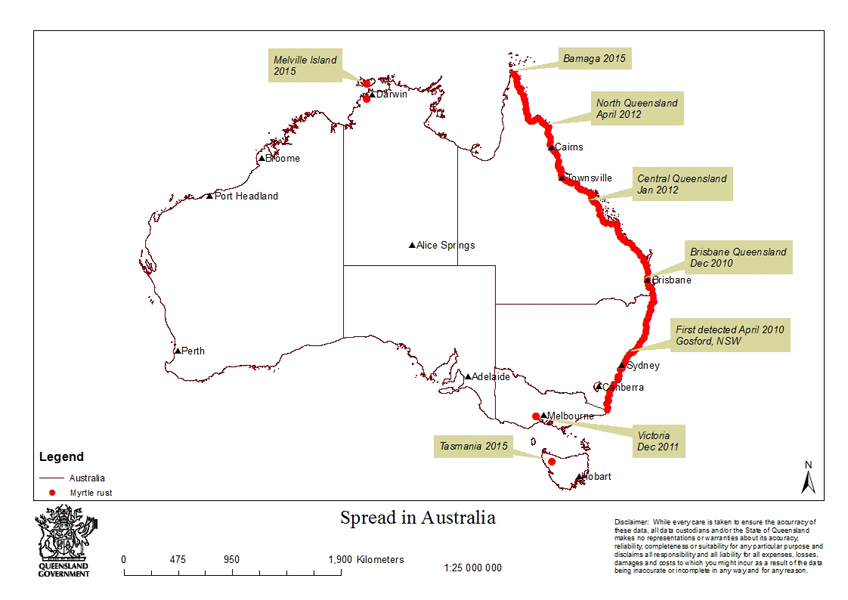
Industry impacts
Myrtle rust has the potential to have severe economic impacts on plant nurseries, native and plantation forestry and new growing industries such as lemon
myrtle production.
The $800 million production nursery industry is an important part of the Australian economy and is vital for supporting a range of other industries such
as fruit and vegetables. Myrtle rust has already damaged the nursery and garden industry significantly, with immediate restrictions on interstate trade
following detection and the removal of popular commercial varieties of plants that are highly susceptible to the disease. Some states still maintain
trade restrictions from areas where the disease is present.
The forest industry contributes over $20 billion of economic turnover each year and employs over 70,000 people (ABARES, 2014). While initially considered
a significant risk to the forestry industry, impacts to date have fortunately been minimal with reports of the disease restricted to minor damage in
young eucalypt plantations in New South Wales (Carnegie, 2015) and Queensland (Pegg, unpublished).
The developing lemon myrtle (Backhousia citriodora) industry has been one of the hardest hit by the disease. Lemon myrtle leaves contain oil with
the highest citral content of any known plant in the world – citral is the lemony aroma compound used for its citrus effect. The leaves are dried and
milled for use in teas or as a spice and steam distillation is used to extract the essential oil from the leaf material, which can then be used as
food flavouring, in aromatherapy products, cosmetics and toiletries. In 2012, production of lemon myrtle was estimated to be between 575 and 1,100
tonnes of leaf and 3 to 8 tonnes of oil, with a farm gate value of between $7 and $23 million.
The introduction of myrtle rust into Australia is jeopardising the growth and success of this industry with the disease causing substantial branch defoliation,
dieback and stunted growth with yield losses estimated to be up to 70 per cent in untreated lemon myrtle plantations.
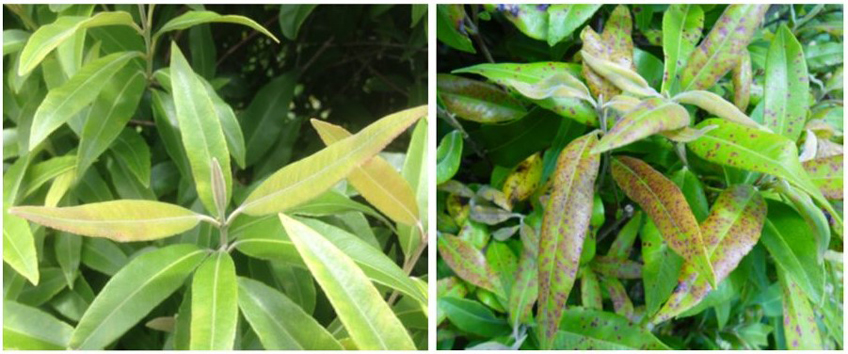
Lemon myrtle - uninfected leaves (left) and infected with myrtle rust (right). Photo - PBCRC
A grower’s perspective: Lemon Myrtle
By Gary Mazzorana, Australia Lemon Myrtle Products Pty Ltd
“From a growers perspective the impact of myrtle rust has been enormous on several fronts. Prior to 2010 Lemon Myrtle was what we regarded as the perfect
crop for the Northern NSW region, as it had virtually no insect pests nor any fungal or bacterial diseases.
Australian Rainforest Products was in the process of becoming Certified Organic, to meet our customer’s ever growing lucrative market, in particular in
the European Union. However, the detection of myrtle rust, which caused significant damage of up to 60-70 per cent loss over eight months of the year,
led us to abandon going down the organic path. Organic Status was no longer a possibility as the only avenue of maintaining reasonable yield and production
was to implement the use of fungicides. The use of these fungicides has also been a major issue in regards to meeting Maximum Residue Levels, which
in itself has had a massive impact on the cost of production. There are also the costs of the research involved in obtaining data for the issuing of
APVMA Permits for use of these fungicides on Lemon Myrtle.
For us to achieve Organic Status we are now forced to look at other extremely expensive options, such as setting up new plantations and processing facilities
in areas with a much dryer environment, which will need to be supplemented by costly irrigation systems.
Australia Lemon Myrtle Products Pty Ltd are also currently sourcing Certified Organic Lemon Myrtle product from Malaysia to meet some of the organic customers’
demands, and are currently looking at a joint venture offshore.”
Environmental impacts
Since first being detected in 2010, myrtle rust has spread rapidly with entire plant species now under threat. In Australia, the Myrtaceae family - which
includes eucalypts, melaleuca and lilly pilly - is diverse, widespread and important to many native ecosystems.
Over half of the world’s approximately 3000 species of Myrtaceous plants are native to Australia and they are an important food source and habitat for
a vast array of animals, birds and insects. The host range for myrtle rust in Australia now includes 350 species of Myrtaceae from 58 different genera.
The impact of myrtle rust has been seen in a range of native forest ecosystems including coastal heath, coastal and river wetlands, sand island ecosystems
and subtropical and tropical rainforests. More than 50 plant species were initially identified as being highly or extremely susceptible to myrtle rust.
"In New South Wales and Queensland myrtle rust disease has already begun to have a serious and detrimental impact on several plant species. The early indications are that this disease will push those species close to extinction in the wild – a catastrophic impact. Efforts are underway to ensure that these at risk species are at least conserved in our seed banks and botanic gardens as a last resort. It is clear from the research to date that this disease is complex and that the negative impacts on different species will range from the immediate through to gradual resulting from a cumulative degradation in the viability of specific species."
Comments from Dr Brett Summerell, Director Science and Conservation, Botanic Gardens & Centennial Parklands Sydney.
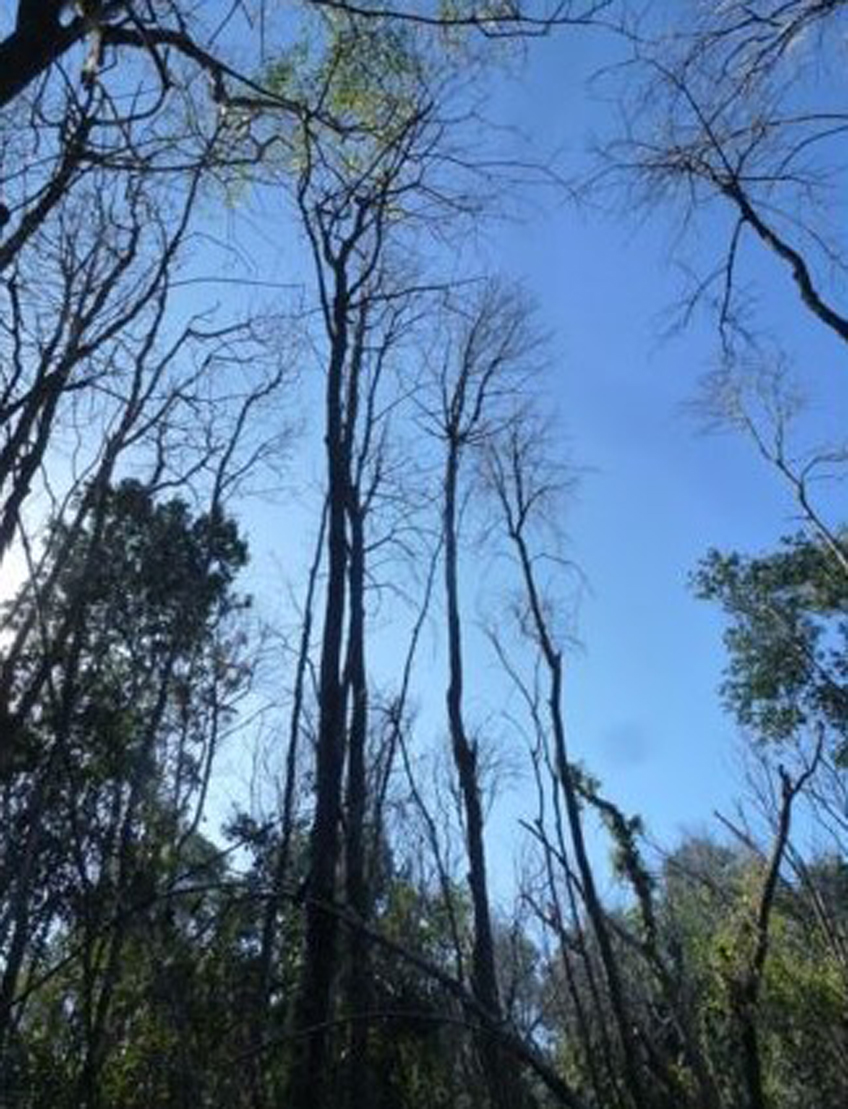
Death of mature native guava (Rhodomyrtus psidioides) in northern NSW as a result of repeated foliage dieback caused by myrtle rust. Photo - P. Entwistle
The risk that myrtle rust poses to threatened Myrtaceae, as listed by Federal and state governments, is becoming more apparent with significant dieback
and tree death recorded as a result of repeated infection. In Queensland alone, eleven of the 23 species listed as endangered - including several species
listed by the Commonwealth - are highly susceptible to myrtle rust with severe impacts recorded (Figure 3). All of the species of Myrtaceae listed
as endangered in Queensland are rated as highly or extremely susceptible. In NSW, myrtle rust is officially recognised as a ‘Key Threatening Process’
that threatens the survival of Myrtaceae ecological communities.
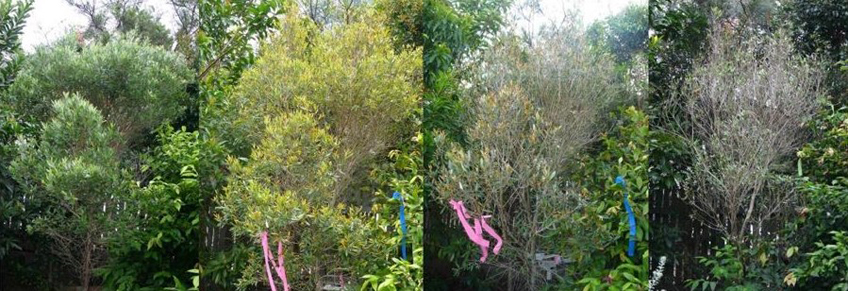
Rapid decline of the Endangered Rhodamnia angustifolia caused by repeated myrtle rust infection. Photo - PBCRC
Myrtle rust research
The PBCRC research project Managing myrtle rust and its impact in Australia is investigating
myrtle rust management options for industry and the impact on native ecosystems.
Nursery and Garden
The research being undertaken into myrtle rust has enabled improved species selection for production and retail nurseries, and for urban tree planting
by councils, by providing myrtle rust host and susceptibility lists (Pegg et al. 2014; Giblin & Carnegie 2015). Additionally, a standardised method
of disease screening and a susceptibility rating system will be made available which will enhance future species and cultivar selections. Field rating
systems have also been developed and will help identify new myrtle rust resistant varieties.
Forest industry
Significant networks have been developed relating to the risk myrtle rust poses to eucalypts nationally and internationally. Using disease screening and
assessment methodologies, populations of commercially significant eucalypt species have been assessed including: Corymbia citriodora sub sp.
citriodora, C. citriodora sub sp. variegata, C. citriodorasubsp.henyri (Pegg et al. 2014), Eucalyptus cloeziana, E. argophloia (Lee
et al 2015 and E. globulus (Unpublished). Other species of international significance have also been assessed including E. grandis, E. camaldulensis,
E. pellita and E. urophylla (Roux et al 2015). As a result of this work there is now a better understanding of resistance patterns
within populations of the different species and how this compares to endemic fungal pathogens, ensuring a strategic breeding program can be implemented.
Additionally, results from these studies are being used to get a better understanding of the genetics controlling resistance (Shuey et al. 2015; Butler
et al. 2016)
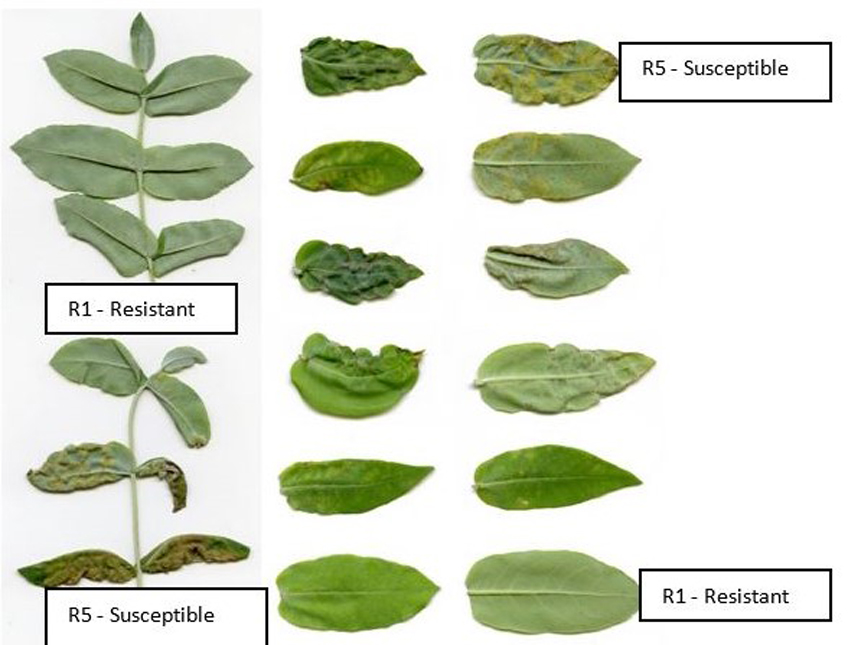
Myrtle rust susceptibility rating using Eucalyptus globulus as an example. Photo - PBCRC
Lemon myrtle
The production of lemon myrtle is an important and developing horticultural and export industry. Through the PBCRC PhD project Epidemiology, impact and management of myrtle rust in lemon myrtle plantations,
student Emily Lancaster is working to help growers implement control strategies to protect productivity.
“Myrtle rust in Australia is jeopardising the growth and success of the lemon myrtle industry. Effective strategies to manage myrtle rust for industry,
beyond the application of fungicides, is hindered by a lack of published information in the following areas:
-
Factors influencing the susceptibility of lemon myrtle to infection by P. psidii;
-
The effect P. psidii has on the growth and yield of lemon myrtle;
-
The influence climatic factors and inoculum density have on the incidence and severity of P. psidii in lemon myrtle plantations; and
-
How the timing of fungicide application affects the incidence and severity of P. psidii in lemon myrtle plantations.
Through my PhD I am aiming to gain an understanding of these different aspects of myrtle rust in lemon myrtle plantations. I hope this will help industry
in their efforts to manage the disease more effectively,” said Emily.
By increasing the understanding of these factors this will assist with the development of an effective evidence-based forecasting system for the disease.
This in turn will help with more informed, effective and economically feasible management decisions to be made around management of myrtle rust, particularly
with regard to fungicide application.
Native ecosystems
The project Managing myrtle rust and its impact in Australia has provided the only
impact data for myrtle rust in native ecosystems in Australia. As a result of this vital research, surveys have been conducted across several species
of Myrtaceae and long term monitoring plots have been established. Species distribution within specific sites has been mapped and resistant/tolerant
individuals identified to aid in future species conservation and regeneration programs.
Interactions between myrtle rust and insects associated with broad-leaved paperbark (Melaleuca quinquenervia) following disturbance have been
examined to determine the combined impacts on regeneration, growth and flower production.
Using glasshouse screening methods, developed as part of this project, regional populations of M. quinquenervia have been studied to determine
levels and patterns of resistance/susceptibility across the host geographic range. Similar studies have been done on two other broad-leaved paper bark
species, M. leucadendra and M. viridiflora, both key ecological species in northern regions of Australia. This will help identify
populations at greatest risk as well as opportunities for plant regeneration programs.
"Data collected since the first myrtle rust outbreak in 2010 indicates that a number of species considered to be widespread and common in some environments are at risk of becoming endangered due to myrtle rust, with the real possibility of extinction of species occurring in the very near future."
Over half of native guava (Rhodomyrtus psidioides) and more than 10 per cent of brush turpentine (Rhodamnia rubescens) have already been
affected badly by myrtle rust. Severe infection has been recorded across different life-stages, including seedlings, saplings and mature trees, with
significant impacts to flower, fruit and seed production (Carnegie et al. 2015). Under the Federal Department of Environment Threatened Species Nomination
process, a population reduction over a ten year period of ≥ 50 per cent would see a species formally listed as Endangered.
Threats to plant communities are also becoming more obvious, with myrtle rust affecting regeneration following disturbance such as fire, including keystone
species like the broad-leaved paperbark (Melaleuca quinquenervia). Such species play a critical role in maintaining the integrity of an ecosystem
and any change to this species may have a dramatic impact on ecological communities as a whole. Assessments to date have shown that around 40 per cent
of trees are significantly affected, with regrowth repeatedly killed by infection. Myrtle rust has also been shown to prevent flowering.
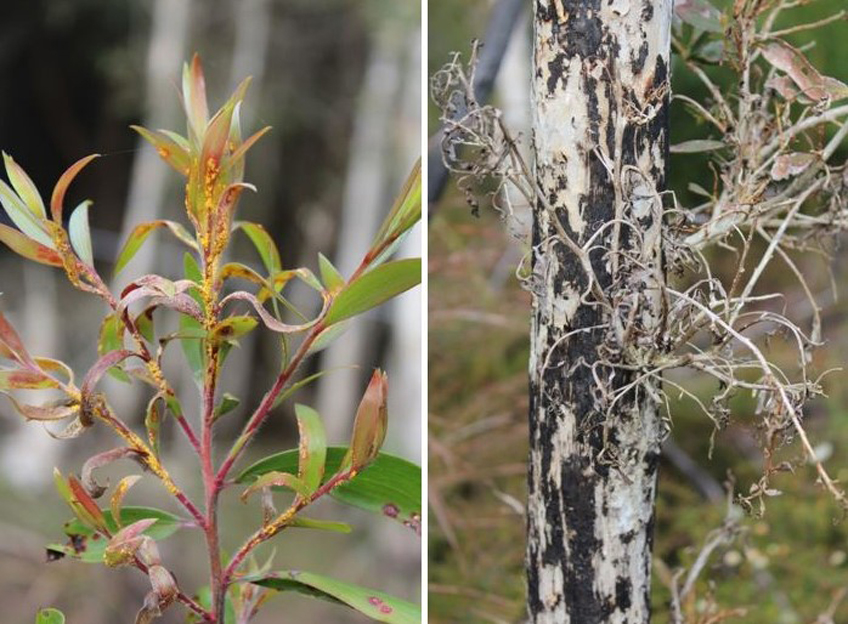
Early symptoms of myrtle rust infection on young Melaleuca quinquenervia (left) and causing death of M. quinquenervia coppice regeneration (right). Photo - PBCRC
While the impact of P. psidii varies depending on the plant host and the environment, it is widely recognised that the full impact of this disease
on our native ecosystems in Australia may take many years to manifest.
Predicting and managing the impacts of myrtle rust is critical to reducing biodiversity losses in susceptible environments.
New Zealand Case Study
Myrtle rust has not been detected in New Zealand. According to climate modelling that has been undertaken in New Zealand, myrtle rust - should it establish
- is most likely to become established in low to mid-altitude areas of the North Island, the northern east coast of the South Island and in the Chatham
Islands area (http://www.biosecurity.govt.nz/pests/guava-rust). While the impact on New
Zealand’s environment has the potential to be severe, there is also the impact on the Māori community to consider. Many susceptible plants are very
significant to the Māori culture.
“Myrtle rust has not been detected in New Zealand, however there is a significant risk that it will arrive. It has been identified as a serious threat. The fungus poses a serious threat to both native and endemic myrtaceous species such as pohutukawa, rata and manuka, and many species which are considered taonga (or treasure) by Māori. Any knowledge that New Zealand can learn from Australia’s response to Myrtle Rust and PBCRC’s research will be beneficial and we look forward to continuing to build these collaborations.”
Comments by Dr David Teulon, Plant and Food New Zealand
Read this case study (click here) that looks at the potential of myrtle rust to be a cultural issue for New Zealand and how our research is helping to deliver better biosecurity outcomes through improving engagement and collaboration with indigenous communities.
Laura Fernandez, PhD student: Impacts of myrtle rust (Puccinia psidii) on native ecosystems
It is important to have updated information on the distribution and impacts of invasive species for governments, scientists and natural resource managers
in order to take wiser decisions when it comes to quarantine, management and control.
In order to gather information regarding myrtle rust extent and impacts on Australian native and managed landscapes, a survey was sent to national parks,
botanical gardens, councils, natural resource management agencies, nurseries and forestry agencies in all states where the fungus is present (NT, QLD,
NSW, VIC and TAS). The survey was sent to more than 500 individuals, obtaining 254 responses. Myrtle rust was reported as widespread in NSW and QLD
gardens and streets as well as native forest. Fortunately, in VIC the fungus was reported only in urban areas but not in native bushland and no occurrences
were reported for NT nor TAS, probably due to its recent arrival (2015) and non-ideal climatic conditions for the fungal spores to germinate. Five
species that are not in the current list of host species were found as well as five new local government areas detected (two in QLD and three in NSW).
Future planned fieldwork as well as glasshouse experiments will help us to understand the consequences that myrtle rust is having on our native communities,
for example after fire when resprouting tissues and seedlings are especially susceptible to myrtle rust infection.
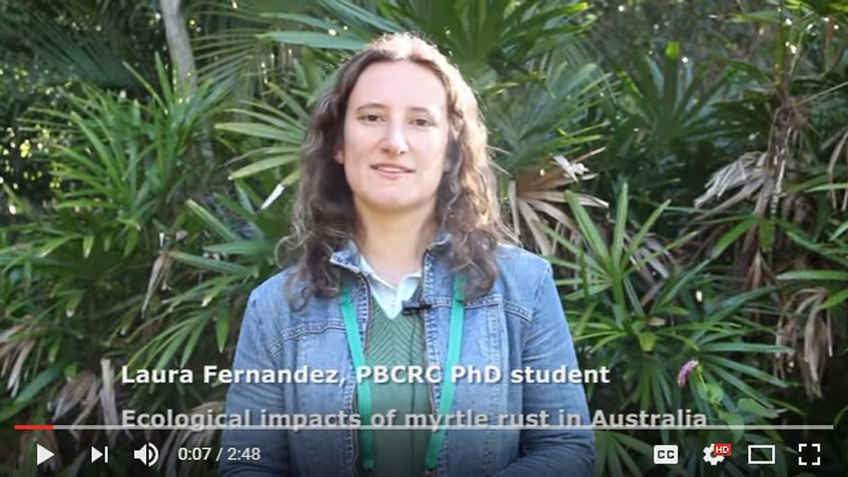
PBCRC myrtle rust research projects
Managing myrtle rust and its impact in Australia, Further information: Dr Geoff Pegg, Queensland Department of Agriculture and Fisheries, Participants: NSW Department of Primary Industries, Queensland Department of Agriculture and Fisheries
References
ABARES 2014a, Australian forest and wood products statistics, March and June quarters 2014, Overview report and data tables, Australian Bureau of Agricultural and Resource Economics and Sciences, Canberra
Butler, JB, J.S. Freeman, R.E. Vaillancourt, B.M. Potts, M. Glen, D.J. Lee and G.S. Pegg. Symptomless and hypersensitive responses of Eucalyptus globulus to the rust pathogen Puccinia psidii: evidence for different QTL underlying each response
Carnegie AJ, 2015. First Report of Puccinia psidii (Myrtle Rust) in Eucalyptus Plantations in Australia. Plant Disease Notes, 99, 161.
Lee, David, Brawner, Jeremy, and Pegg, Geoff 2015. Screening Eucalyptus cloeziana and E. argophloia populations for resistance to Puccinia psidii. Plant Disease 99, 71-79.
Shuey, Louise Geoff Pegg, Sanushka Naidoo 2015. Eucalyptus grandis defence responses against the myrtle rust pathogen, Puccinia psidii – insights from RNA-SEQ transcriptome profiling. APPS conference September 2015
Shuey, Louise, Geoff Pegg, Sanushka Naidoo 2015. Eucalyptus grandis defence responses against the myrtle rust pathogen, Puccinia psidii – insights from transcriptome profiling. IUFRO Tree Biotech